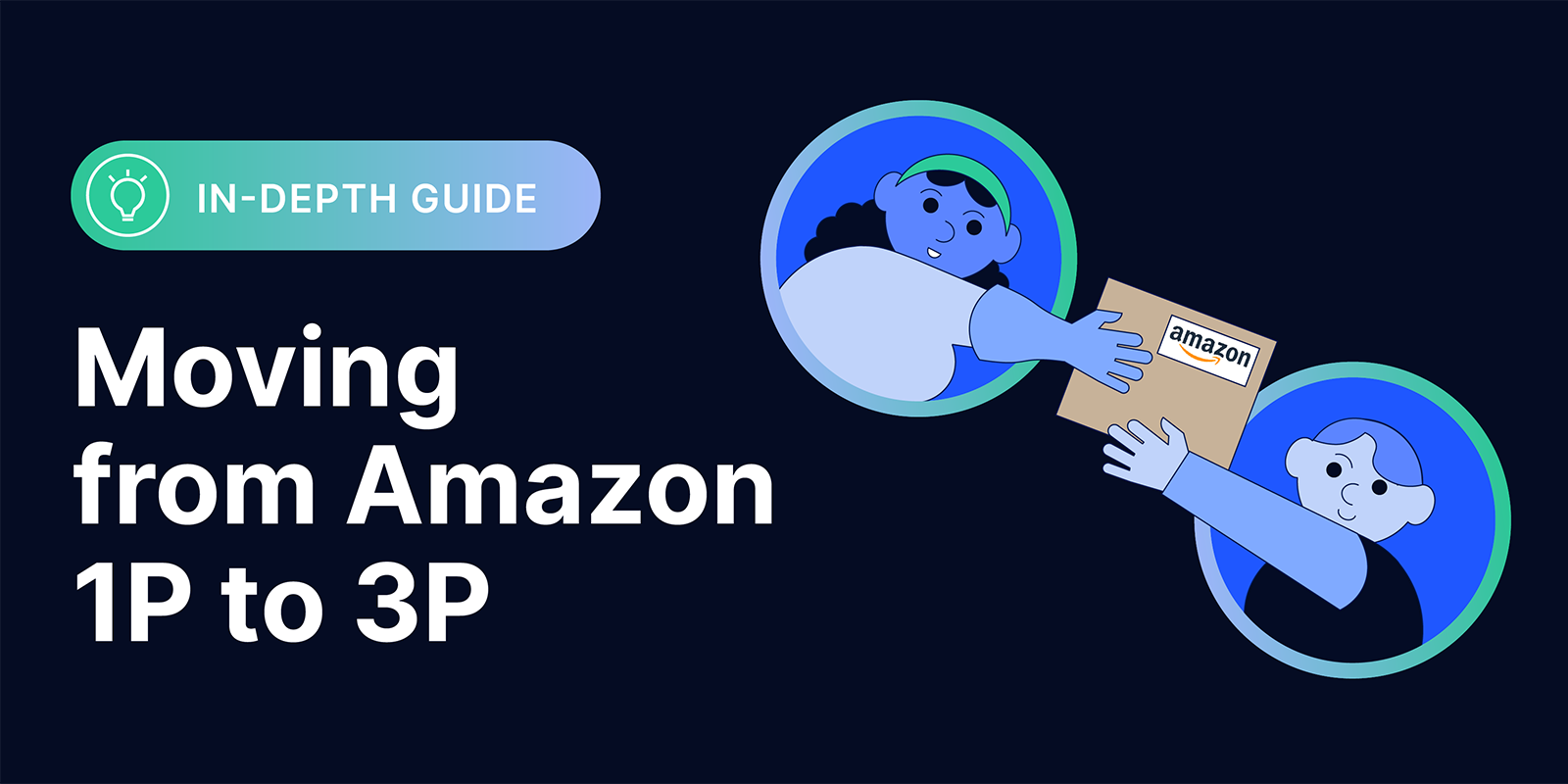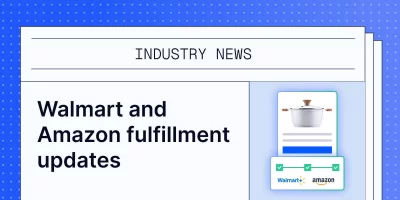Following 2024 reports of a number of Amazon vendor (1P) relationships being canceled, suppliers selling directly to Amazon have the opportunity to start selling directly to consumers through Amazon Marketplace (3P) instead.
The transition from 1P to 3P includes some new challenges that prepared sellers can overcome, and opportunities to gain a competitive edge over other 3P sellers in the marketplace.
Transitioning from Amazon 1P to 3P
1P vendors selling directly to Amazon are familiar with Amazon managing prices, inventory, and customer orders on the Amazon platform.
Making the jump from 1P to 3P can feel like an overhaul of familiar operations because it’s more hands-on. Amazon sellers have to keep listings and inventory synchronized, as well as manage customer orders and tend to listing errors. Fortunately, Feedonomics offers the technology and service to make direct-to-consumer ecommerce on Amazon scalable.
Keep reading to learn more about product listing and synching, order management, and maintaining data quality.
Listing products and keeping them up-to-date and optimized
On Vendor Central, brands need Amazon’s approval for every product category they plan to sell, and because inventory is managed by Amazon, they must submit support requests for any changes to their listings. On the other hand, on Amazon Seller Central, brands are responsible for managing their own listings from start to finish.
To sell products on a marketplace, sellers need to match the marketplace’s data specifications. 1P vendors are familiar with Amazon’s rules for product categorization and required attributes, but they might not know the best practices for creating optimized Amazon listings that stand out amongst the competition on the site.
For example, while Amazon product titles that perform best generally follow a specific structure, it’s still a good idea for brands to test different structures to further optimize their listings. You might want to put your brand name in the middle of your titles instead of the front, the way diaper brands do (because people tend to shop by diaper size rather than brand name). Or you might find that the word “kids” performs better than “children” in your titles.
Testing simple changes like these sometimes takes weeks on Vendor Central, but on Seller Central, it can take just a few minutes if you have the right technology to manage your catalog.
Optimizing your data is well worth it. According to a 2023 Feedonomics survey, the average marketplace customer saw a 21% increase in channel revenue, an 18% lift in clicks, and an 18% increase in conversions—all while spending 43% less time on feed management.
Adding new products is also more straightforward on Seller Central than Vendor Central if you are familiar with Amazon’s product category template and can provide the required attributes. However, managing large catalogs can be a full-time job. To save time, you can use a feed management platform to create unique exports for multiple sales channels without changing the source data.
Updating prices, inventory, and product assortment can all be simplified through a feed management platform that transforms your data across multiple channels.
Managing orders
One of the biggest differences between 1P selling and the 3P model on Amazon is the process of managing orders. 1P vendors are accustomed to sending Amazon inventory and letting Amazon take care of individual customer orders. With 3P, sellers have a few different options.
The most similar fulfillment option for vendors moving to Seller Central is the Fulfilled By Amazon (FBA) program. In the program, sellers send Amazon inventory and Amazon fulfills orders to the customer. This usually enables faster shipping speeds through Amazon’s delivery network and Prime.
However, it doesn’t always make sense to use FBA for an entire product assortment. For lower-margin products, sellers may prefer to fulfill the orders themselves. In this case, they need a process for retrieving and processing orders from Seller Central.
Doing this manually can be time-consuming and error-prone, especially with high order volumes. The best solution is to automate order pass-through with technology that syncs orders and inventory reductions across systems and channels.
For even more control over your fulfillment, you can use order routing and splitting tech to direct orders to different fulfillment methods. For example, you can route particular SKUs to one warehouse, or split line items of a single order to different fulfillment locations.
Remember, order management has a big impact on your seller reputation, so you need a sustainable and effective process for keeping customers happy.
Protecting your data quality
Maintaining high-quality listings is one of the best ways for marketplace sellers to keep revenue flowing.
To scale effectively, sellers must focus on two key areas: expanding the number of sales channels and improving the quality of their product feeds, which are essential for every ecommerce business. These two elements come together in the concept of the Feedprint™, a measure of a business’s channel exposure and product availability across those channels.
We highlight the importance of the Feedprint in our Product Feedprint Benchmark Report. Using customer data, the report shows how sellers who increased their Feedprints and optimized their product data achieved significant ecommerce growth.
Any seasoned ecommerce seller will tell you that listing errors are one of the most important hurdles to overcome on a marketplace. Fixing listing errors ensures that you maximize product availability. Because Amazon and other channels have strict data requirements, it’s inevitable that some listings are disapproved and require changes.
Feedonomics enacts multiple measures to protect and improve seller data quality:
- Inventory buffers to prevent overselling
- Export conditions to only list selected products
- Hard stops that prevent bad data from being published
- Alerts that warn you of potential issues or missing values
Check out our article to learn all the ways Feedonomics helps protect your data quality.
A full-service solution for marketplaces
Feedonomics combines powerful technology with 24/7 support to help sellers save time on integration, improve data quality, manage orders, and find success on marketplaces.
Amazon 1P vs. 3P FAQs
What is the difference between Amazon 1P and 3P selling?
Amazon 1P sellers sell their products wholesale to Amazon, which then resells them to consumers. In contrast, 3P sellers list and sell products directly to customers through Amazon Marketplace, managing their own pricing and inventory.
What are the profit margin differences between 1P and 3P sellers?
Profit margins tend to be lower for 1P sellers since Amazon dictates pricing and wholesale costs. 3P sellers have more pricing control, allowing for higher profit margins but requiring active management of fees like referral fees and fulfillment costs. You should also keep in mind Amazon’s rules around competitive pricing and minimum advertised price.
How do purchase orders work for 1P sellers?
1P sellers receive purchase orders (POs) from Amazon, which decides how much inventory to buy. These sellers then ship products to Amazon’s fulfillment centers. In contrast, 3P sellers manage their own stock levels and sales flow.
What challenges do sellers face when transitioning from 1P to 3P?
Moving to 3P requires hands-on management of inventory, pricing, and order fulfillment. Sellers also face new fees (referral fees, fulfillment fees), chargebacks, and customer service responsibilities that were previously handled by Amazon.
What fulfillment options do 3P sellers have?
3P sellers can use:
- Fulfilled by Amazon (FBA): Amazon handles storage, shipping, and customer service.
- Fulfilled by Merchant (FBM): The seller manages storage and shipping directly.
How does pricing control differ in 1P vs. 3P?
1P sellers have little control over product pricing, as Amazon sets retail prices. 3P sellers, on the other hand, have more pricing control, allowing them to adjust prices based on competition and profitability. However, you should keep in mind Amazon’s rules around competitive pricing and minimum advertised price.
How does Amazon’s Brand Registry impact 1P vs. 3P sellers?
Brand Registry helps both 1P and 3P sellers protect their brand and control product listings. However, 3P sellers benefit more because they have greater control over product detail pages with A+ Content and listing optimization.
What are chargebacks, and how do they affect 1P sellers?
Chargebacks are fees Amazon imposes on 1P sellers for compliance issues like late shipments, incorrect packaging, or labeling errors. 3P sellers do not face the same chargeback fees, but must manage customer returns and order fulfillment efficiency in order to keep their seller account in good standing.
What are the main advantages of switching from an Amazon 1P to an Amazon 3P selling model?
- Greater pricing and inventory control, reducing dependence on Amazon’s central account for stock management.
- Higher potential profit margins due to control over pricing and wholesale prices.
- More flexibility in fulfillment options (FBA or FBM), allowing sellers to tailor logistics to their needs.
- Ability to expand product assortment without Amazon’s approval, giving sellers direct control over their catalog.
- Direct control over brand presence and customer base, ensuring a stronger connection with consumers.
- Less reliance on Amazon’s central account for inventory forecasting, reducing unexpected supply chain disruptions.
What are the main disadvantages of switching from an Amazon 1P to an Amazon 3P selling model?
- Increased responsibility for inventory management, as sellers must handle forecasting, inventory levels, and restocking without Amazon’s direct purchase orders.
- Higher operational complexity, requiring businesses to handle customer service, returns, and order fulfillment directly.
- No guaranteed sales volume, as Amazon no longer commits to purchasing inventory, leaving sellers responsible for demand generation and marketing.
- Potential need for working with distributors, which can increase supply chain complexity for businesses that previously relied on Amazon’s procurement system.
- More competition with third-party sellers, requiring strategic pricing and listing optimization efforts to maintain visibility.
- Additional compliance responsibilities, such as adhering to minimum advertised price policies and avoiding account suspensions due to seller performance issues.

Mario is a senior content marketing manager based in Texas. He enjoys solving problems, learning about new ecommerce tech, and breaking down complex topics into useful tips for readers.



